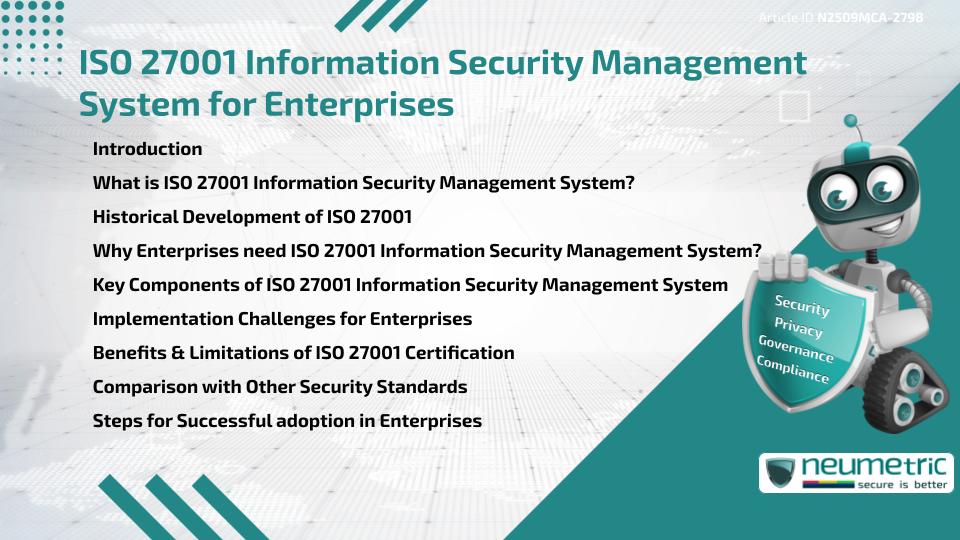Table of Contents
ToggleIntroduction
The ISO 27001 Information Security Management System is a globally recognized Framework that helps Enterprises protect Sensitive Data, reduce Risks & comply with Regulations. By implementing this standard, Organisations can safeguard Information Assets, improve resilience against Cyber Threats & demonstrate trustworthiness to Clients & Stakeholders. This article explains what ISO 27001 Information Security Management System is, its history, benefits, challenges, comparisons with other standards & how Enterprises can successfully adopt it.
What is ISO 27001 Information Security Management System?
The ISO 27001 Information Security Management System is an internationally accepted Standard that sets requirements for creating, implementing & maintaining an Information Security Management System [ISMS]. Its purpose is to protect Confidentiality, Integrity & Availability of information through a structured Risk Management process. For Enterprises, it acts as both a shield & a Roadmap to establish strong Security Practices.
Historical Development of ISO 27001
The origins of ISO 27001 Information Security Management System date back to the British Standard BS 7799 in the 1990s. Over time, it evolved under the International organisation for Standardisation [ISO] into the more comprehensive ISO/IEC 27001 Framework. The Standard has undergone revisions to address emerging Cyber Risks, keeping it relevant for Modern Enterprises.
Why Enterprises need ISO 27001 Information Security Management System?
Enterprises handle large volumes of Sensitive Information such as Financial Data, Client Records & Intellectual Property. Without proper safeguards, these assets are vulnerable to Breaches. Implementing ISO 27001 Information Security Management System ensures that Risks are identified & mitigated, Legal Compliance is maintained & Customer Trust is strengthened. In Industries where reputation is critical, such as Finance & Healthcare, this Framework is especially vital.
Key Components of ISO 27001 Information Security Management System
The ISO 27001 Information Security Management System consists of several essential elements:
- Risk Assessment & Treatment: Identifying Vulnerabilities & applying Controls.
- Information Security Policy: Setting the foundation for Rules & Practices.
- Leadership Commitment: Ensuring Management actively supports security initiatives.
- Continuous Improvement: Regular monitoring & updates to adapt to new Threats.
- Documentation & Evidence: Keeping clear records to prove Compliance & Accountability.
These components function like pieces of a puzzle, working together to provide a complete & effective Framework.
Implementation Challenges for Enterprises
Adopting ISO 27001 Information Security Management System is not without obstacles. Some challenges include high initial costs, Employee resistance to new processes & the complexity of maintaining Compliance. Small & Medium Enterprises may find resource allocation difficult, while larger Organisations may struggle with scaling Policies across Global Operations. However, with proper Planning & Staff training, these challenges can be managed effectively.
Benefits & Limitations of ISO 27001 Certification
The benefits of ISO 27001 Information Security Management System Certification include:
- Enhanced Security Posture against Cyber Threats
- Improved Legal & Regulatory Compliance
- Stronger Business reputation & Customer confidence
- Streamlined Internal Processes & Risk Management
Limitations include significant investment of time & resources, the need for ongoing monitoring & the fact that Certification does not guarantee absolute security. Like a safety belt, it reduces Risks but cannot prevent every possible accident.
Comparison with Other Security Standards
Enterprises often compare ISO 27001 Information Security Management System with other frameworks such as SOC 2, HIPAA & NIST. While these standards have sector-specific applications, ISO 27001 is broader & internationally recognised. Its focus on Risk Management & Continuous Improvement makes it more versatile for Enterprises that operate across multiple Industries & Countries.
Steps for Successful adoption in Enterprises
Enterprises can adopt ISO 27001 Information Security Management System by following these steps:
- Conduct a thorough Gap Analysis against current Security Practices.
- Secure Leadership commitment & allocate sufficient Resources.
- Train Employees on roles & responsibilities in Information Security.
- Develop & document Security Policies tailored to the Organisation.
- Engage in Internal Audits & Continuous Monitoring.
- Undergo External Certification for validation.
This structured approach helps Enterprises implement the Standard effectively & maintain Compliance over time.
Conclusion
The ISO 27001 Information Security Management System is a vital Framework for Enterprises aiming to protect Sensitive Data, build resilience & gain Customer Trust. Despite challenges, the benefits of adopting it outweigh the costs, making it a strategic investment in long-term Security & Compliance.
Takeaways
- Provides a structured approach to Data Security
- Enhances Compliance with Laws & Regulations
- Boosts Customer Trust & Market Reputation
- Requires strong Leadership & Staff involvement
- Demands Continuous Monitoring & Updates
- Can be resource-intensive for some Enterprises
FAQ
What is the purpose of ISO 27001 Information Security Management System?
It provides a Framework to secure Sensitive Data, reduce Risks & ensure Compliance with Regulations.
How does ISO 27001 Information Security Management System benefit Enterprises?
It strengthens defenses against Cyber Threats, builds Client Trust & improves Internal Processes.
Is Certification in ISO 27001 Information Security Management System mandatory?
Certification is not mandatory but is often required by Clients, Regulators & Business Partners.
What are the main challenges in adopting ISO 27001 Information Security Management System?
Challenges include high Costs, Employee resistance & complexity in maintaining Compliance.
How long does it take to implement ISO 27001 Information Security Management System?
Depending on Enterprise size & complexity, implementation can take from several months to over a year.
Does ISO 27001 Information Security Management System guarantee complete Security?
No, it reduces Risks but cannot eliminate all possible Threats.
How is ISO 27001 Information Security Management System different from SOC 2 or HIPAA?
ISO 27001 is broader & internationally recognised, while SOC 2 & HIPAA are sector-specific.
Need help for Security, Privacy, Governance & VAPT?
Neumetric provides organisations the necessary help to achieve their Cybersecurity, Compliance, Governance, Privacy, Certifications & Pentesting needs.
Organisations & Businesses, specifically those which provide SaaS & AI Solutions in the Fintech, BFSI & other regulated sectors, usually need a Cybersecurity Partner for meeting & maintaining the ongoing Security & Privacy needs & requirements of their Enterprise Clients & Privacy conscious Customers.
SOC 2, ISO 27001, ISO 42001, NIST, HIPAA, HECVAT, EU GDPR are some of the Frameworks that are served by Fusion – a SaaS, multimodular, multitenant, centralised, automated, Cybersecurity & Compliance Management System.
Neumetric also provides Expert Services for technical security which covers VAPT for Web Applications, APIs, iOS & Android Mobile Apps, Security Testing for AWS & other Cloud Environments & Cloud Infrastructure & other similar scopes.
Reach out to us by Email or filling out the Contact Form…





